We all love potatoes, right? Whether they’re mashed, boiled, roasted, or baked – potatoes are a staple food for many families. And growing your own potatoes is not as difficult as it might seem! In fact, potatoes are pretty low-maintenance vegetables and can be grown in your garden or even in pots. But how long do potatoes take to grow?
I get it! You want to see the fruits of your labor as soon as possible. But here’s the thing – potatoes take some time to grow. The exact timeframe depends on many factors, including the type of potatoes and weather condition.
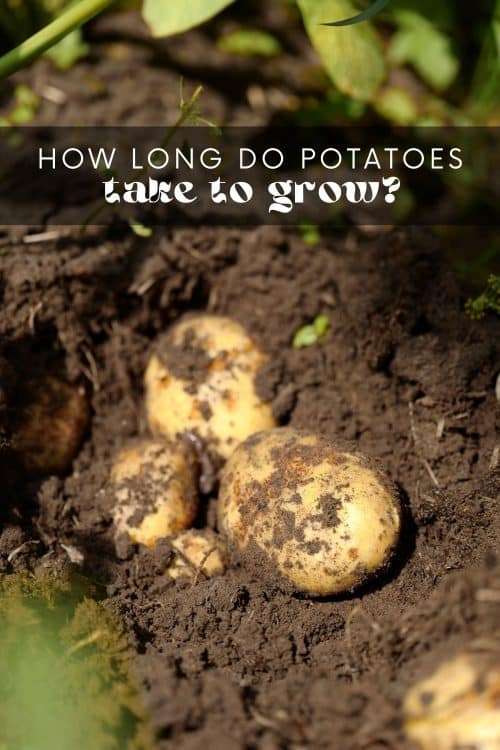
How Long Does It Take Potatoes to Grow?
Like many other vegetables, potatoes (solanum tuberosum) come in different varieties that have varying growth rates. It’s best to choose the type of potato that suits your climate and growing conditions. Potato types can be separated into three categories: early, mid-season, and late.
Here’s a general guideline on how long each potato type takes to grow:
- Early-Season Potatoes: Also referred to as the first earlies or new potatoes, these plants take approximately 60-80 days to mature. You’re best planting early if you live somewhere where the summers get very hot. Plant your early-season potatoes 3-4 weeks before the last frost date in your region.
- Mid-Season Potatoes: Known also as the second earlies, mid-season potatoes mature between 80-100 days. They have a longer growing time than early-season potatoes but produce larger yields. Plant your mid-season potatoes 2-3 weeks after the first batch of early-season potatoes.
- Late-Season Potatoes: These potatoes are the last to mature and are known as main crop potatoes. They take around 100-135 days to grow and are best for prolonged storage. Late-season potatoes are ideal for cooler climates, where the summer stays mild and the growing season is longer.
Types of Potatoes: Early, Mid-Season, and Late
There are over 5000 different types of potatoes, which means you have a lot of options to choose from! Which variety you choose will not only affect the flavor and texture of your potatoes but also determine how long it takes for them to grow.
Early-Season Potatoes
These potatoes are the first to mature, meaning you’ll have fresh new potatoes to enjoy earlier in the season. They are also smaller potatoes and have delicate, thin skin that is perfect for boiling.
Here are some popular early-season potato varieties:
- Irish Cobbler
- Yukon Gold (can also be mid-season)
- Red Norland
Early-season potatoes are perfect for those who can’t wait to start harvesting!
Mid-Season Potatoes
Also known as the second earlies, mid-season potatoes have a longer growing time than early-season varieties. They’re perfect for those who want a balance between the early and late-season potatoes.
Some mid-season potato varieties:
- Russet Burbank
- Red Gold
- Yellow Finn
Mid-season potatoes are great for those who want the best of both worlds – an earlier harvest with larger, more flavorful potatoes.
Late-Season Potatoes
These varieties take the longest to mature and are usually harvested in late summer or early fall. They have thicker skin and tend to be larger potatoes compared to early and mid-season potatoes.
Try these late-season potatoes:
- Maris Piper
- Kennebec
- German Butterball
Late-season potatoes are ideal for storing and can last for several months in a cool, dark place.
When Is the Best Time to Plant Potatoes?
The best planting time for potatoes depends on the type you’re growing and your climate. While having a specific planting date is helpful, it’s more important to pay attention to the soil temperature. The ideal growing temperature for potatoes is between 65°F-80°F (18°C-26°C) or 55°F-65°F (12°C-18°C) during the night.
For early-season varieties, aim to plant them 3-4 weeks before the last expected frost date in early spring. This is usually mid-March in cooler regions. Mid-season and late-season varieties can be planted a bit later, in early to mid-April.
If you live in a warmer climate, it’s best to start planting earlier in the year. Potato plants don’t do well in hard frost or in temperatures over 100°F (37°C).
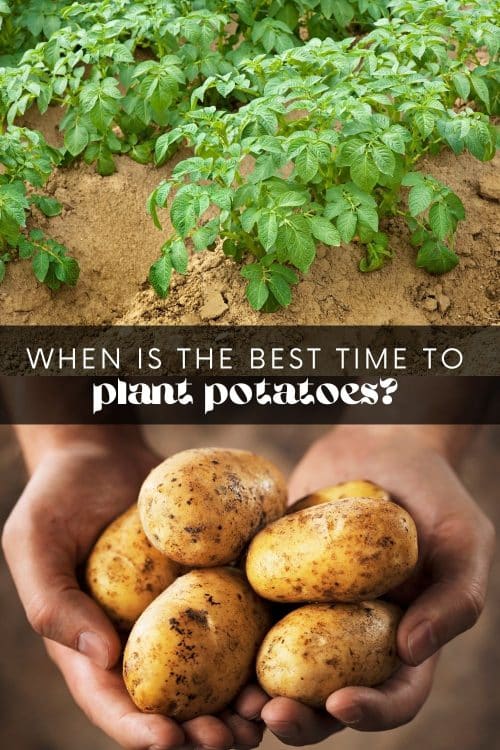
What are Seed Potatoes?
Potatoes don’t produce seeds, so how do you grow them? Instead, potatoes are grown from ‘seed potatoes’.
Seed potatoes are small potatoes that have been grown for the purpose of planting them and growing more potatoes. They have small ‘eyes’ or sprouts on them, which will eventually grow into a potato plant.
When choosing seed potatoes, look for firm ones with no signs of rotting or damage. You can also use larger seed potatoes and cut them into smaller pieces, as long as each piece has at least one eye/sprout.
It’s important to use certified disease-free seed potatoes to ensure a healthy crop.
How to Plant Potatoes
Planting potatoes is super easy for and can be done with just a few simple steps:
- Chitting (optional): Chitting is the process of allowing seed potatoes to sprout before planting. This can help with faster growth and larger yields, but it’s not necessary. Lay your seed potatoes on a tray or egg carton in a cool, well-lit area for 4-6 weeks before planting.
- Prepare the soil: Potatoes prefer loose, well-draining soil with access to full sun for around 6 hours a day. Add compost or organic matter to improve the quality of your garden bed and soil.
- Cut seed potatoes (if needed): If you’re using larger seed potatoes, cut them into smaller pieces with at least two eyes/sprouts on each piece.
- Plant the seed potatoes: Dig a hole for each seed potato/seed piece, about 4-6 inches deep. Place the seed potatoes with the sprouts facing up. Plant each seed potato about 16-18 inches apart to allow room for growth.
- If planting in a container: Fill a large container with 6 inches of potting soil, then place 1-3 seed potatoes on top.
- Cover with soil: Gently cover the seed potatoes with soil. They should be completely covered but not buried too deep.
- Water thoroughly: After planting, water until the soil surface is evenly moist but not soaked. Potatoes need consistent moisture to grow, so make sure to water them frequently.
- Hilling: Hilling is the process of mounding soil around the base of the plants as they grow. This helps to promote tuber growth and protect the potatoes from sunlight, which can turn them green (green potatoes are toxic in large amounts). Hill up the soil around your new plants when they reach about 6-8 inches tall. Stop hilling the surface of the soil once the plants start to flower.
How Often Should You Water Potato Plants?
Potatoes need consistent moisture, but be careful not to overwater, as this can lead to rot and disease. On average, potatoes should be watered about 1-2 inches weekly. However, the frequency may vary depending on your climate and soil type. If the two inches of soil feels dry, it’s time to water.
Potatoes grown in containers may need to be watered more frequently as they tend to dry out faster. Check the soil daily and water when needed.
Potato Plant Care Tips
No one likes a mushy, rotten potato! Here are some tips to help you care for your potato crop:
- Fertilize: Before planting, mix a balanced fertilizer into the soil. This will provide essential nutrients for plant growth.
- Mulch: Adding mulch around your potato plants can help retain moisture and suppress weed growth.
- Monitor for pests and diseases: Keep an eye out for common potato pests! Aphids, Colorado potato beetles, and wireworms can all cause damage to your plants. Also, watch for signs of diseases such as potato blight.
- Weeding: Keep the area around your potato plants free from weeds, as they can compete for nutrients and water.
- Frost: Potato tubers are not frost tolerant! Cover your plants if a late frost is expected.
How Do You Know When Potatoes Are Ready to Harvest?
After you’ve planted your potatoes, they’ll need time to grow and mature. You’ll know when they’re ready to harvest based on the variety you’ve planted. Early varieties can be harvested when the plants start to bloom and flower.
For maincrop varieties, wait until the foliage starts to die back and turn yellow. You can also dig up a few potatoes to check their size and if they are ready for harvest.
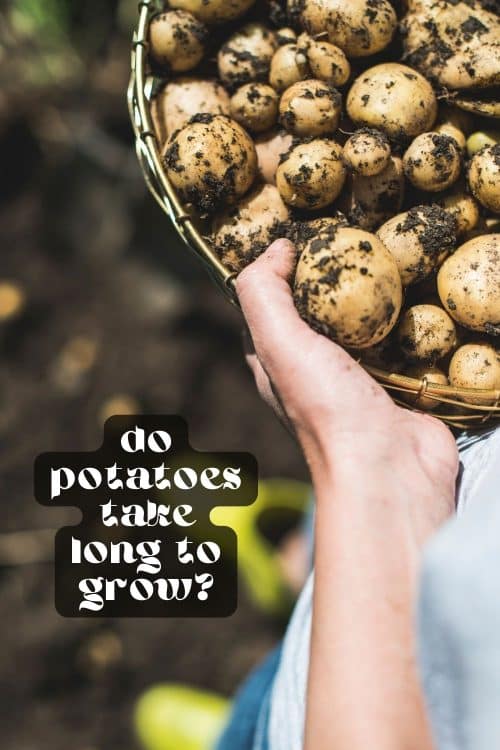
How to Harvest Potatoes
Now you know when potatoes are ready to be eaten, it’s harvest time! Here are the steps to follow:
- Wait for the plants to flower OR for the foliage to die back and turn yellow.
- Use garden fork or shovel for the best results. Gently loosen the soil around the plants.
- Carefully lift the plants out of the ground, being careful not to damage any of the potatoes.
- Discard any damaged or diseased potatoes.
That’s it! If you’re ready to use them right away, simply rinse them off and enjoy fresh from the garden.
How to Store Homegrown Potatoes
Maincrop potatoes are best for storing, as they have a thicker skin that protects them from rot. However, even early varieties can be stored if properly cured first.
Curing involves leaving the potatoes in a cool, dry place for 2-3 weeks after harvesting so they can develop tougher skin. Don’t wash them until you’re ready to use them, as excess moisture can cause them to rot.
Once cured, store your potatoes in a dark, cool place with good air circulation. Avoid storing them near onions, as they release gases that can cause potatoes to sprout prematurely.
Best Recipes for Potatoes
Now that you have successfully grown and harvested your own potatoes, it’s time to enjoy them in some delicious recipes! Here are a few ideas to inspire you:
- Steakhouse Mashed Potatoes
- Dutch Oven Potatoes
- Cheesy Ham and Potato Soup
- Crockpot Hashbrown Casserole
- Herby Creamed Potatoes
- Twice Baked Potato Casserole
- Herb Potato Bread
- Crispy Potato Wedges
- Oven Roasted Potatoes
Potatoes are incredibly versatile and can be used in many different dishes. Plus, when you grow them yourself, they just taste better than any from the grocery store!
No, sweet potatoes are not actually potatoes! They belong to the same family of plants as Morning Glory and have a different nutritional profile and taste compared to regular potatoes. To grow sweet potatoes, you must plant slips (small sprouts) rather than seed potatoes. Most sweet potatoes take about 100 days to mature and should be harvested before the first frost.
Potatoes can be grown in a variety of containers, including large pots, buckets, and even trash cans! The key is to make sure the container has good drainage holes, as potatoes prefer well-drained soil.
No! They contain high levels of solanine, which can be toxic if consumed in large quantities. You can, however, compost potato leaves to add nutrients back into your soil.
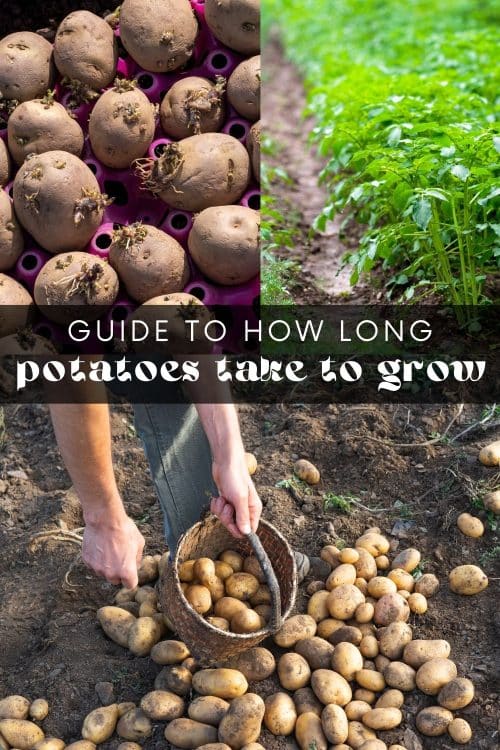
Check out these Gardening Posts:
- DIY Tall Planter Box
- DIY Self-Watering Window Boxes
- When to Plant?
- How to Set Up a Garden Drip System
- Gardening Tips for Beginners
- Winter Squash Storage
- Tips for Growing Herbs Indoors
- Building Raised Wooden Planter Boxes
- Starting Plants from Seed Indoors
- How to Make Hummingbird Food
- How Long Do Potatoes Take to Grow?
- How to Grow and Harvest Lettuce
- The 5 Best Soil Moisture Meters
- How to Grow Jalapenos
- How to Grow Green Onions
- How to Grow Big Tomatoes in Pots
- How to Grow Broccoli
- How to Grow a Corn Plant
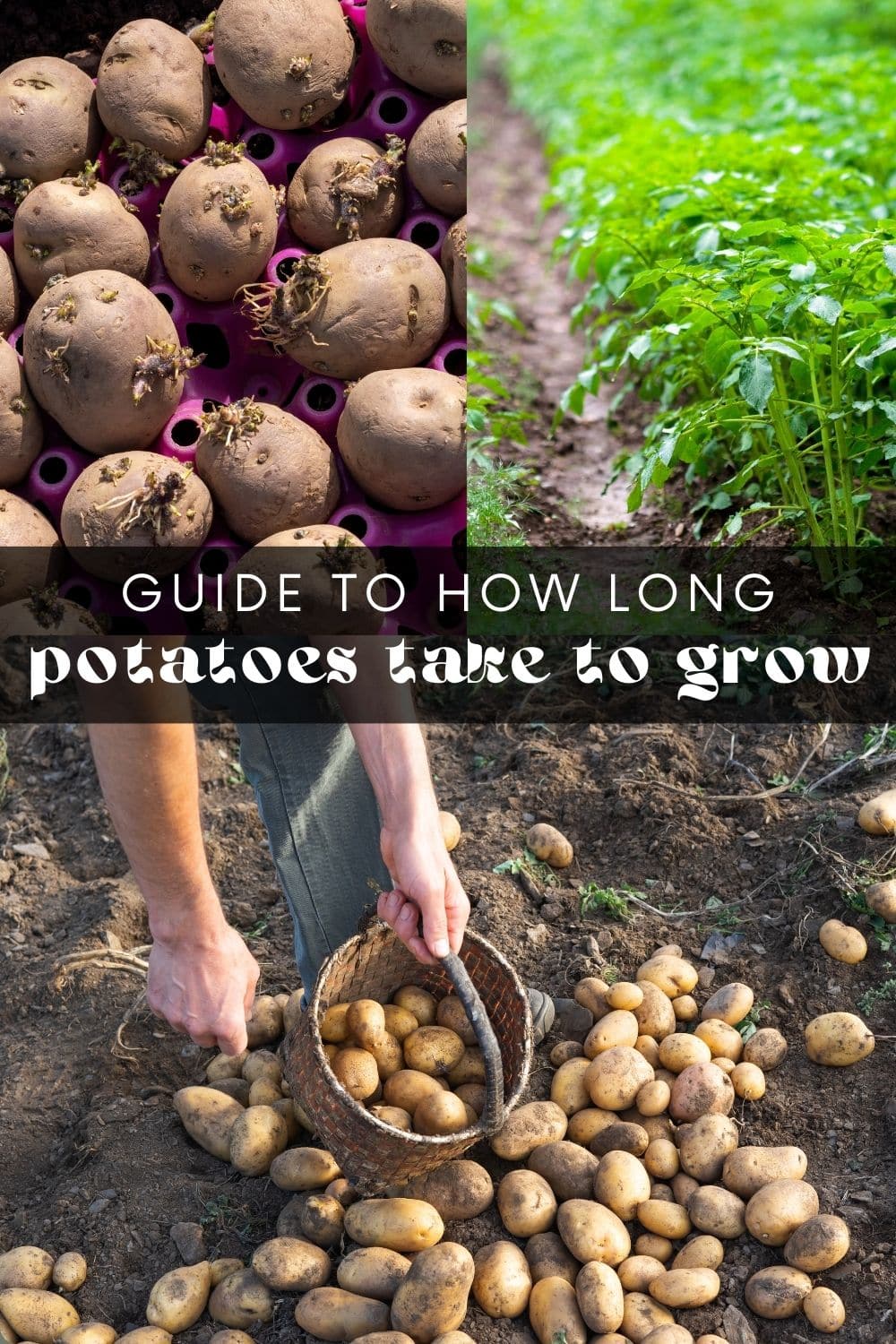
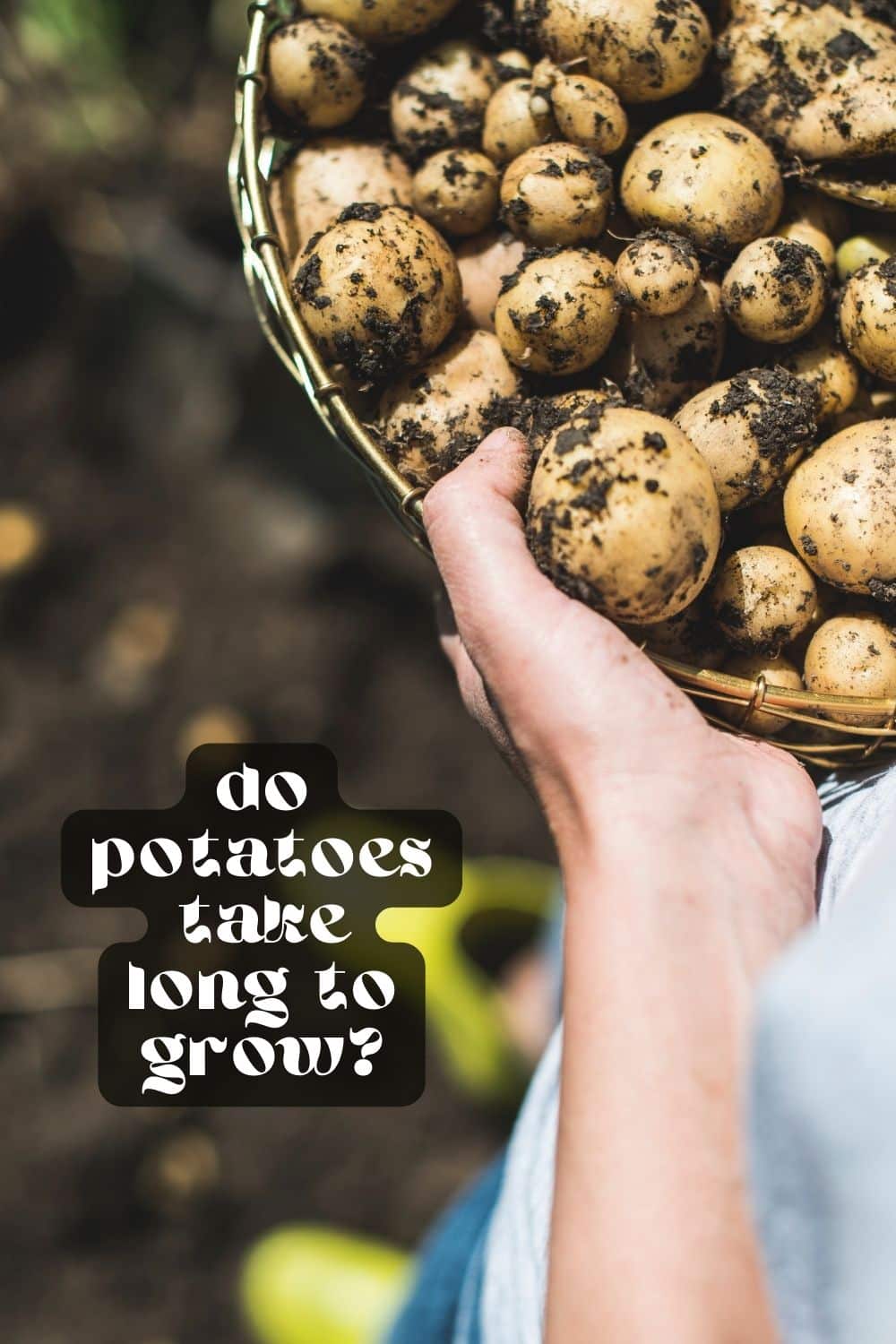
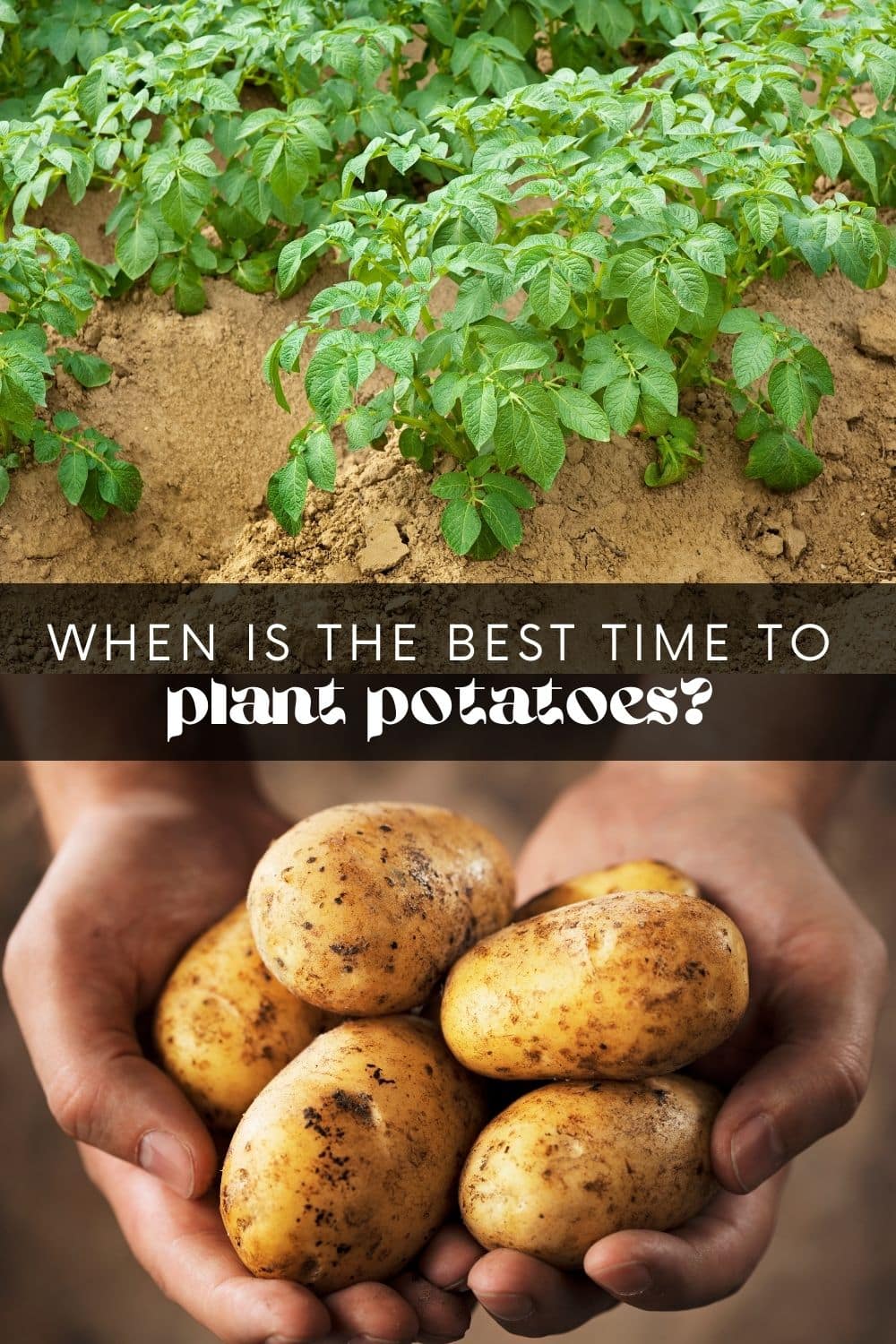
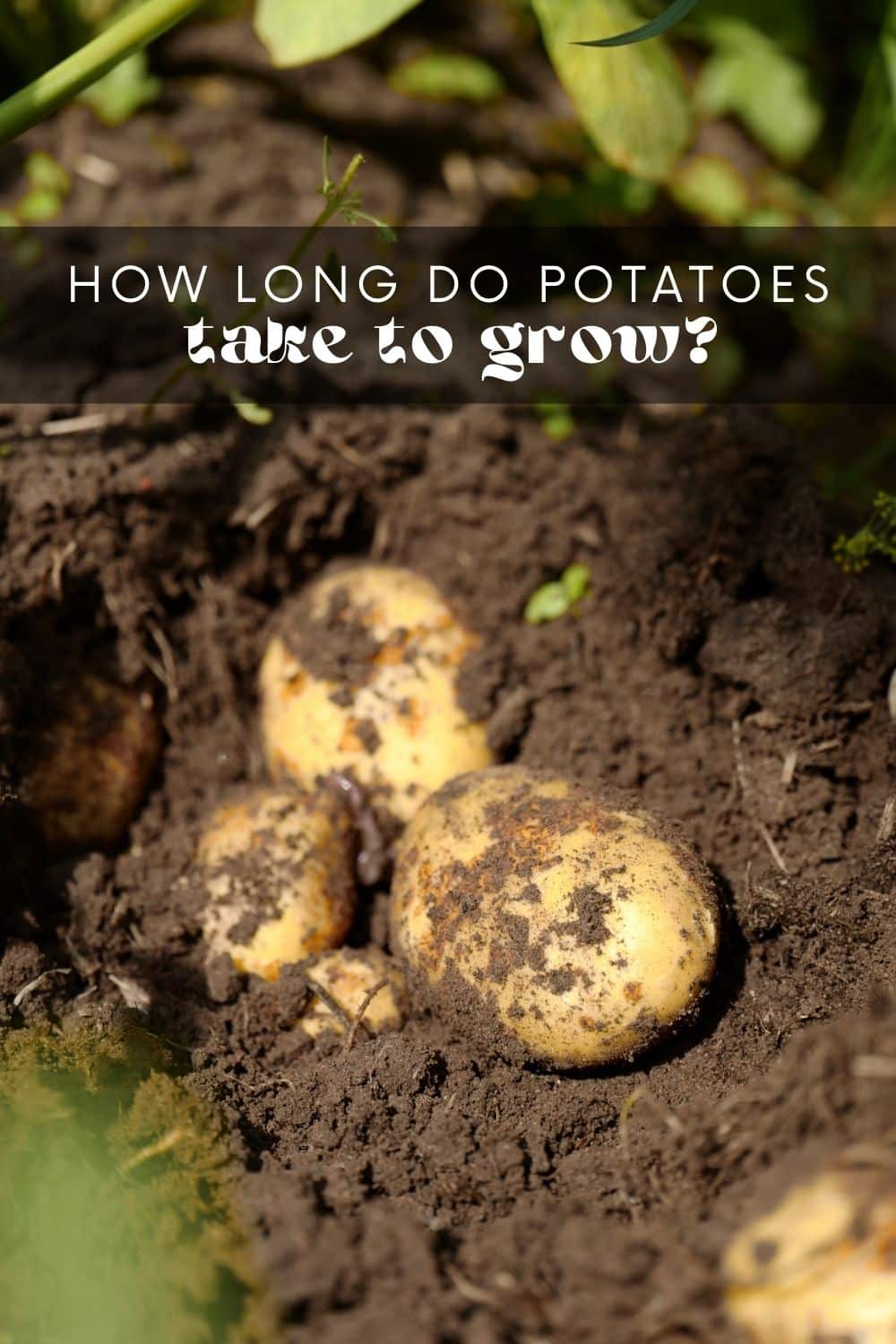





[…] How Long Do Potatoes Take to Grow? […]